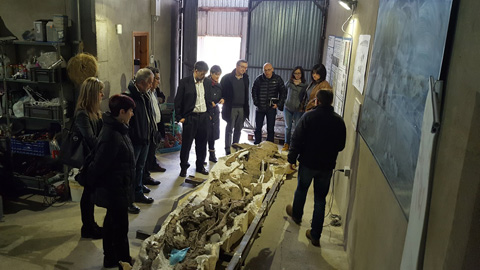Two new UAB archaeology and palaeontology campuses

23/03/2017
The city councils of Isona and Conca Dellà and the Dinosfera museographic centre signed a collaboration agreement for the creation of two new archaeology and palaeontology campuses in Coll de Nargó and Pallars Jussà. The event included the presence of Margarida Arboix, Rector of the UAB; Jeannine Abella, Deputy Mayor of Conca Dellà; Martí Riera, Mayor of Coll de Nargó; Armand Sánchez, Vice Rector for Research and Transference, UAB; Carlos Sánchez, Vice Rector for Institutional Relations and Culture, UAB; Salvador Moyà, Director of the Institut Català de Paleontologia Miquel Crusafont (ICP); Àngel Galobart, Director of the Museum of Conca Dellà and Dinosfera, and Head of the Mesozoic research group at the ICP; Antoni Teixell, Director of the UAB Department of Geology, and David Manuel Gómez, lecturer of the Department of Geology.
UAB Archaeology and Palaeontology Campuses
The Universitat Autònoma de Barcelona, through its Department of Geology, and alongside the Institut Català de Paleontologia Miquel Crusafont, have spent years collaborating with the city councils of Isona i Conca Dellà and Coll de Nargó in the fields of research and teaching in Palaeontology. This collaboration can be defined by the work experiences offered to palaeontology students and by the different research projects and palaeontology assignments conducted at the sites of Pallars Jussà and Coll de Nargó.
The creation of the UAB Palaeontology Campus has given way to the research and scientific development in the fields of geology, palaeontology and in geopalaeontological heritage, and is an essential tool for the training of students. The campuses are also an important revitalising element for the palaeontological and geological heritage of the region and an ideal place in which to disseminate scientific results among academics and the general public. This contributes to promoting the different sites, the Museum of Conca Dellà and Dinosfera as referent points of the Pyrenees.
The UAB aims to contribute to the value of Catalonia's cultural heritage by providing the work done by its different archaeology and palaeontology groups around the country with the recognition of an Archaeology and Palaeontology Campus. The two new campuses will join the UAB's other seven campuses: La Noguera, La Draga, El Castellot, Torre Llauder, Mines de Gavà, Vall d’en Bas and Guissona.
Coll de Nargó
The palaeontological site of Coll de Nargó (Alt Urgell) is of great scientific value and has become a worldwide palaeontological referent for the quality and abundance of the extraordinary findings. The palaeontological area includes the largest quantity of dinosaur eggs known to exist in Europe and one of the most important worldwide. Also conserved at the site are ichnolites and bones from dinosaurs, other animals and plant remains in a large diversity of strata, which makes Catalonia one of the few places in the world in which a lot of information on the configuration, behaviour and disappearance of these large reptile 66 million years ago has been gathered.
The area comprising the palaeontological site containing dinosaur eggs from the Sallent River Valley is located between the old town of Sallent and the town centre of Coll de Nargó, located in the county of Alt Urgell. Given the large extension of land containing fossilised strata, researchers took into account the most abundant areas and individualised four main sites according to their extension, and the quantity and quality of the data. These sites, from west to east, are named after the following toponyms: Sallent, Pinyes, Santa Eulàlia and Cal Salider.
In addition to the sites, Coll de Nargó also includes the Dinosfera museographic centre, focused on the reproduction of dinosaurs. Its exhibit is divided into nine areas in which visitors can discover through audiovisuals, interactive games, real fossils, replicas and reconstructions, all the knowledge scientists currently have on the reproduction of these animals which populated the Pyrenees 66 million years ago.
Pallars Jussà
Conca Dellà (Pallars Jussà) conserves one of the most important palaeontological sites containing dinosaur remains in all of Catalonia. A layer of sediments from the Late Cretaceous passed through Catalonia from east to west at the foothills of the Pyrenees and this is where the main palaeontological sites from the period ranging from 72 to 66 million years ago can be found.
The dinosaur remains found at Conca Dellà are conserved in rocks of different origins which make up two geological formations: the formations Gresos d'Areny and Tremp. These two formations were deposited right when the Pyrenees mountain range began to rise. They appeared all over north, east and south of Conca Dellà.
Within the municipalities of Conca Dellà, Tremp and Abella de la Conca there are a number of palaeontological sites, both with dinosaur fossils (bones, tracks and eggs), as well as other vertebrates and also plant remains.
Located in the town of Isona, the Museum of Conca Dellà is the scenario of an exciting journey back in time. This museum offers the possibility of discovering an area which in earlier times was occupied by Romans and much before that, by some of the last dinosaurs to roam the Earth.
The Cretaceous Park is a project developed locally and based on the integral heritage of Conca Dellà. The Cretaceous Park therefore allows everyone arriving to the Pallars Jussà region to discover this territory and its different thematic environments: palaeontological sites, archaeological remains, historical-artistic buildings, as well as the natural surroundings in which it is set.